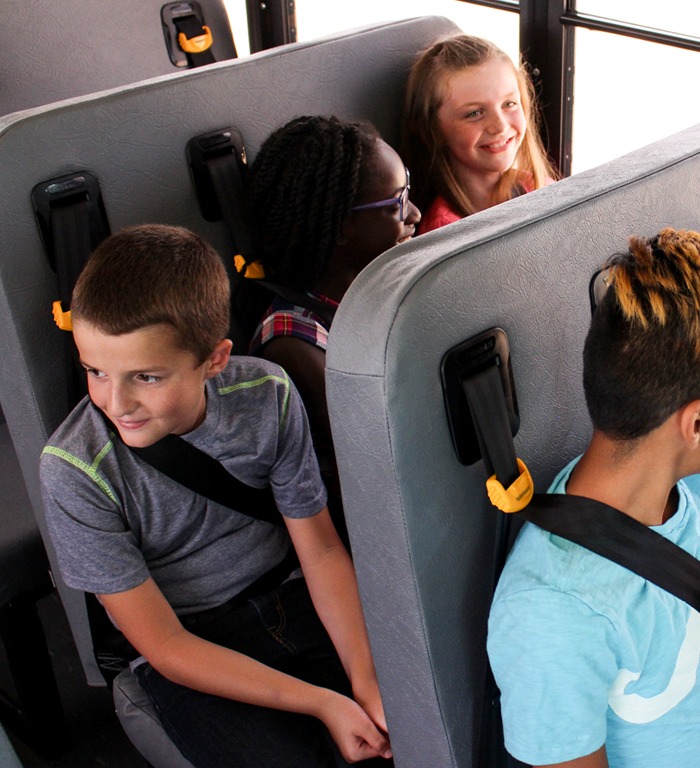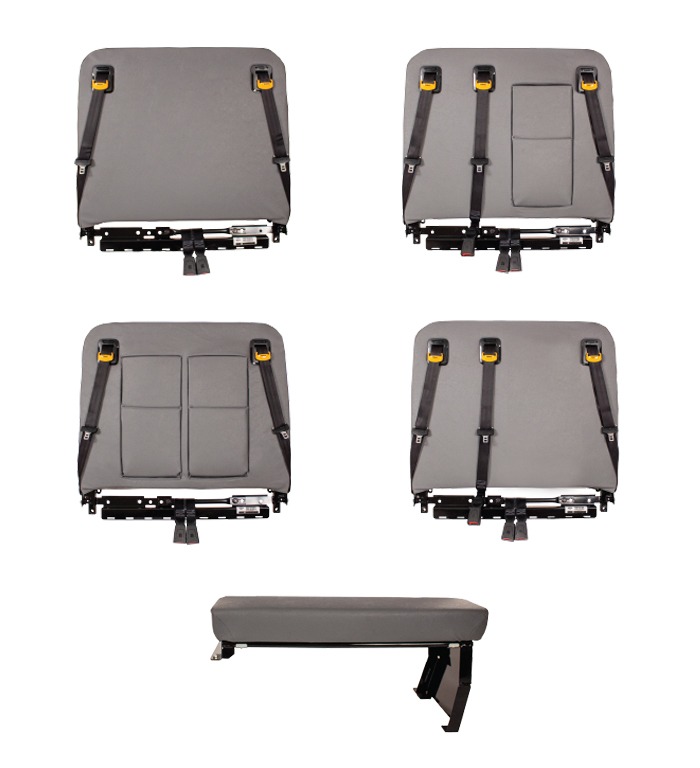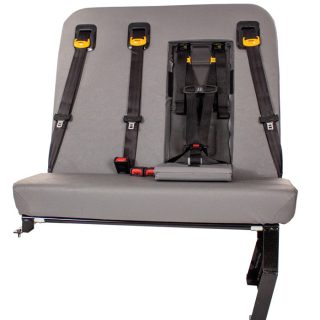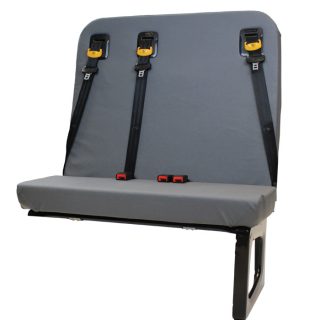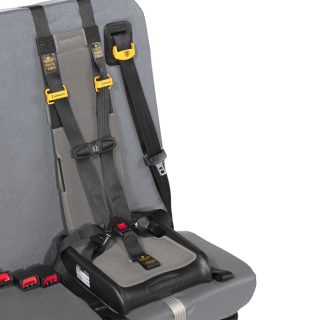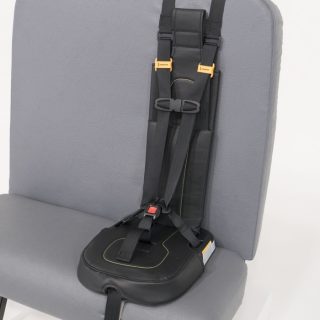SafeGuard FlexPlus is the best designed, easiest to maintain, and highest performing seat available for Thomas and Collins school buses. The SafeGuard seat product line is the only to come with SmartFrame Plus technology. Like the SafeGuard BTI, FlexPlus is designed to provide enhanced compartmentalization for belted AND unbelted students. They also come with SafeGuard’s exclusive TattleTale Indicator that lets you know when SmartFrame Plus has deployed and it’s time to replace the seat. No other seat manufacturer makes anything like it. Not even close.

SafeGuard FlexPlus
FlexPlus Features
SmartFrame Plus
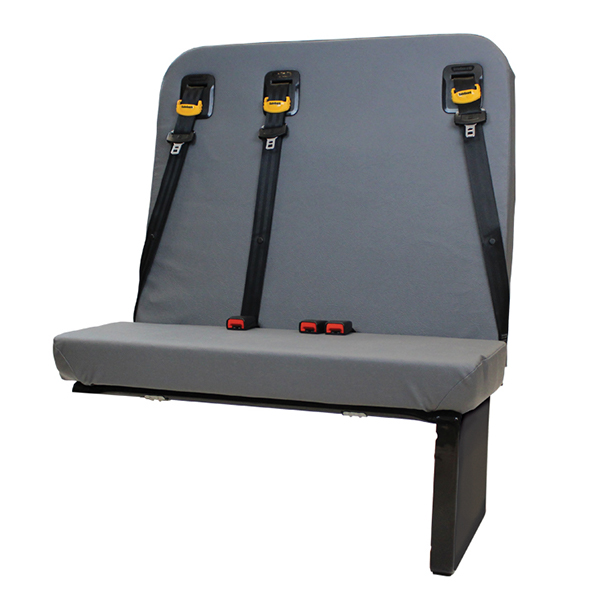
TattleTale Indicator
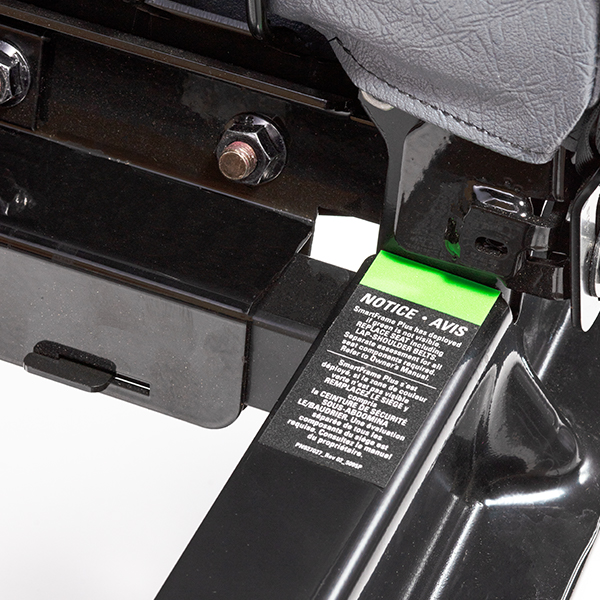
Lap-Shoulder Belts
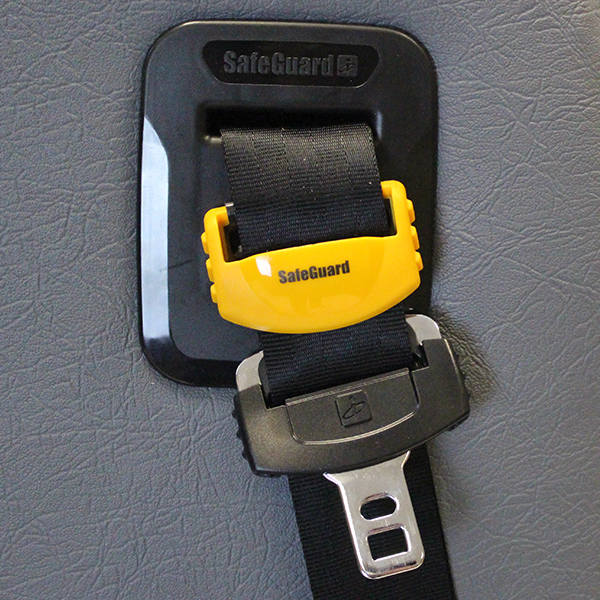
Interchangeable Backs
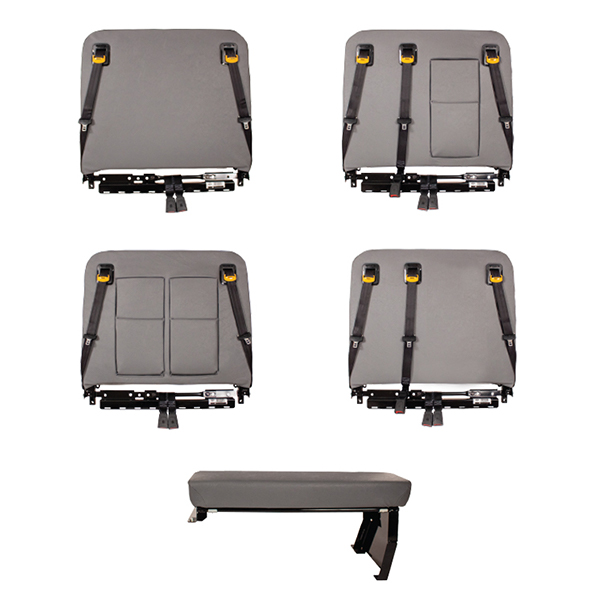
Sliding Buckles
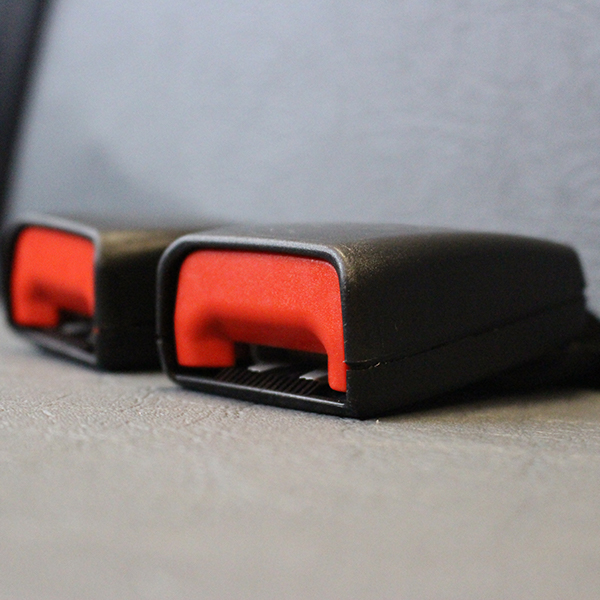
Safety Benefits
- Features SafeGuard 3-point lap-shoulder belts to save lives and reduce injuries.
- Contains SafeGuard’s SmartFrame Plus technology which enhances compartmentalization for belted and unbelted passengers.
- Along with an enforced usage policy, seat belts can reduce bullying and bad behavior by keeping children in their seats. This also reduces driver distraction.
- The SafeGuard TattleTale Indicator reveals if SmartFrame+ has deployed, and the seat should be replaced after a crash.
- Sliding shoulder height adjusters and buckles accommodate children of a wide range of heights.
- Easy access and service to restraint systems and upholstery to keep the seat in good working condition.
- CAPE tested to meet or exceed all federal and state safety standards.
FlexPlus
Related Industries
SafeGuard Seats FAQ
The following is a list of common questions about IMMI’s SafeGuard School Bus Seating products. If you have additional questions, please contact customer service at safeguard@imminet.com or 877-447-2305.
Upgrading Seat Backs
Q: How are SafeGuard Seat Backs upgraded?
+ ×A: Upgrading the SafeGuard SmartFrame Plus Seat is a simple process.
1. Open the seat back cover along its bottom side connector.
2. Remove the two bolts at the aisle side attaching the seat back to the seat base.
3. Remove the two bolts at the wall side attaching the seat back to the seat base.
4. Raise and remove the original seat back from the seat base.
5. Lower the upgraded seat back and install the four seat back attachment bolts.
6. Assemble the seat back bottom side cover joint connector.
Q: How does the use of SafeGuard seating differ from retrofit seating?
+ ×A: The SafeGuard base seat design offers a standardized platform that easily exchanges to belted seating options in less than ten minutes without removing seats from the bus. With SafeGuard Seats, schools can add lap-shoulder belts or integrated child seats to any route at any time. The upgraded seat has been tested and certified to be compliant with applicable Federal and state safety standards
In comparison, retrofit requires the complete removal and replacement of seating. In some cases, additional structural reinforcements such as supplied brackets may be need.
Compartmentalization
Q: How are children currently protected in non-belted seats during school bus accidents?
+ ×A: In non-belted school bus seats, the current form of safety protection for children on school buses is known as compartmentalization. This passive form of restraint relies on closely spaced, high-back padded seats. In a frontal collision, children impact the seat in front of them, which absorbs their energy. Compartmentalization was first required on new school buses in 1977.
Q: How does compartmentalization protect children?
+ ×A: In the event of a frontal crash, the padded seat backs yield to absorb the energy of the unbelted child who impacts the seat back and then ideally returns the child to their original seating position. If the child is partially in the aisle or not seated properly upright and facing forward, compartmentalization offers less effective protection in a frontal collision. In the event of a rollover or side-impact collision, compartmentalization offers virtually no protection for children. In these types of accidents, children are likely to be ejected out of their seats, and injuries are likely to occur. Seat belts provide the best protection in any moving vehicle.
The 1999 National Transportation Safety Board (NTSB) Special Investigation Report concluded: “Current compartmentalization is incomplete in that it does not protect school bus passengers during lateral impacts with vehicles of large mass and in rollovers, because in such accidents, passengers do not always remain completely within the seating compartment.” 1.
Q: What has changed since compartmentalization was implemented that we need lap-shoulder belts on school buses?
+ ×A: According to the American Trucking Association, since 1980 travel on US highways has nearly doubled. The nation’s population has risen 27 percent; heavy truck registrations have increased by 61 percent; heavy truck vehicle-miles traveled have risen by 102 percent, and passenger vehicle-miles traveled have gone up by 87 percent. Yet the highway system has only been expanded by about three percent over the same period. In this new era of heavy traffic on US highways, school buses share roads with more heavy trucks and passenger vehicle traffic.
School buses are now used more often for longer distance school trips and sporting events, requiring travel on interstates and highways. This increases the likelihood that there will be a high-speed crash. Students are too often not properly seated within their compartments and will not receive available protection. All of these factors together result in a potential for more deadly collisions on school buses and potentially increased liability for the school district.
Q: What is SmartFrame and SmartFrame Plus?
+ ×A: With exclusive SmartFrame and SmartFrame Plus technology, SafeGuard bus seats provide the protection of lap-shoulder belts for belted passengers, while offering full compartmentalization protection for unbelted passengers in a frontal collision.
The SafeGuard SmartFrame is a seat back made with two structures. The inner structure provides lap-shoulder belts and absorbs crash energy for the belted passenger. The outer seat back structure remains upright to provide compartmentalization for anyone in the seat behind who is not wearing a seat belt.
The SmartFrame Plus seat back is a single structure that senses loads from the lap-shoulder belt and from the unbelted passenger behind and manages the crash energy between the two to provide both compartmentalization protection as well as lap-shoulder belt protection.
Both SmartFrame and SmartFrame Plus offer a maintenance advantage because of simple access and easy service of restraint systems and upholstery.
Q: What safety advantages do SafeGuard seats have over other belted school bus seats?
+ ×A: With SmartFrame and SmartFrame Plus technology, SafeGuard bus seats are proven to deliver full compartmentalization protection to unbelted passengers in frontal crashes. Other belted seats available on the market are designed with belts attached to a single frame structure, which creates one of two passenger protection challenges:
If the seat back is too weak, it will fold with the belted passenger in a frontal crash, minimizing compartmentalization protection for any unbelted passengers in the seat behind. If the seat back is too strong, it can create injuries for unbelted passengers seated behind.
SafeGuard seats are made by IMMI, home of CAPE Testing. This gives SafeGuard the advantage to develop their seats using dynamic crash testing. This real world type testing helps SafeGuard seats to cause lower injury values for belted and unbelted passengers, compared to seats with single frame designs.
Q: Will an unbelted child have any protection in the SafeGuard school bus seats?
+ ×A: SafeGuard school bus seats, standard with SmartFrame and SmartFrame Plus technology, offer full compartmentalization to unbelted occupants in a frontal collision. Of course, belted students will be better protected in any type of accident.
Lap-Shoulder Belts on School Buses
Q: Will the addition of lap-shoulder belts affect school bus capacity?
+ ×A: Before SafeGuard/IMMI introduced FlexSeat in 2007, seat designs that included lap-shoulder belts took away flexibility and reduced overall bus capacity by forcing the choice of seats with either two or three positions. Because of this constraint, school transportation directors were forced to purchase additional buses, reduce routes or change routes to optimize the use of their buses. The introduction of the SafeGuard FlexSeat alleviated these concerns by offering the flexibility of transporting either two or three children on every seat, while ensuring that they all have lap-shoulder belts.
Q: Which states require seat belts on school buses?
+ ×A: California (2005), Texas (2017), New Jersey (2019), Nevada (2019) and Iowa (2019) require lap-shoulder belts on new buses. New York, and Florida require lap belts on new buses. Each year, 20 to 30 states have bills calling for seat belts to be mandatory on new school buses. Most proposed bills are driven by local grassroots activity.
Q: Will children wear lap-shoulder belts on school buses?
+ ×A: Children come out of the hospital buckled into a car seat. They’re conditioned from birth to be belted while in a moving vehicle. Pilot studies and field studies have shown that with proper administered policies in place, compliance rates are very high. As with any other bus behavior policies, seat belt usage policies must be actively communicated for the safety of the children.
Q: Will lap-shoulder belts improve children’s behavior and reduce bullying on school buses?
+ ×A: While the safety advantages of lap-shoulder belts usually push school districts to move ahead with lap-shoulder belts, transportation managers and drivers say the behavior benefits are the most significant daily impact they see. Children are less inclined to move around in their seats, stand while the bus is moving or talk to those several rows away from them. There is no greater deterrent to bullying and unruly behavior than keeping children in their seats. Additionally, when children stay in their seats, drivers are less distracted, further improving safety on the school bus.
Q: Can lap-shoulder belts be used as weapons?
+ ×A: In the past, some lap belts were designed with a heavy steel buckle threaded on a long web, making them possible to swing. Modern lap-shoulder belts use retractable systems for the lightweight tongue. As with most passenger cars, the buckle is attached to the seat with a short piece of webbing, making them impossible to swing.
Q: How will students get out of lap-shoulder belts if there is an accident?
+ ×A: Just like fire drills in schools, evacuation training is essential for all students riding A: In the past, some lap belts were designed with a heavy steel buckle threaded on a long web, making them possible to swing. Modern lap-shoulder belts use retractable systems for the lightweight tongue. As with most passenger cars, the buckle is attached to the seat with a short piece of webbing, making them impossible to swing. school bus, whether the bus is equipped or not equipped with restraints. Training prepares children to respond calmly in the event of an accident.
Students are less likely to be injured in a bus accident when they are wearing restraints. A properly restrained child who has not been injured can release himself and evacuate more quickly than one who requires a stretcher for evacuation. Per Federal requirements, buckles are designed and tested to unlatch with the same force on the button whether the belt has no load or is fully loaded by the weight of the passenger.
In an emergency, the most significant limitation to evacuation of a bus is the design of emergency exits. A large number of evacuees must move through a single exit door, one at a time, to one person on the outside. In an accident, this process creates a greater evacuation challenge than the additional second required to release a restraint.
Q: How will students evacuate from a bus with lap-shoulder belts if the accident involves fire or deep water?
+ ×A: As noted in the response above, a properly restrained child who has not been injured is much better able to evacuate in any type of accident.
Evacuation training is essential for all students riding a school bus, whether the bus is equipped or not equipped with restraints. Training prepares children to respond calmly in the event of an accident, and the key element in a quick evacuation is uninjured, conscious passengers. In an accident without belts, the risks of injury and unconsciousness increase greatly.
Q: Is the operation of FlexSeat intuitive to children and young adults?
+ ×A: IMMI engineers conducted a usage study in 2007 and 2010 with the FlexSeat, evaluating how children ages 6 to 16 interacted with the product. Approximately 60 children were involved in the study. Even without instruction, none of the children used the product improperly. With very minimal training, children were all able to use the sliding dual buckle and the shoulder height adjuster for greater comfort.
Of course, as with any other school bus procedures, children should be educated in the proper use of SafeGuard school bus seating.
NHTSA on Lap-Shoulder Belts
Q: What is the federal regulation for lap shoulder belts on school bus seating.
+ ×A: Effective since October 21, 2011, the National Highway Traffic Safety Administration (NHTSA) has regulated the design and performance of lap-shoulder belt protection on school bus seating. FMVSS 222 now focuses on improving the crashworthiness of school buses and making school travel safer for children by mandating lap-shoulder belts for buses 10,000 lbs. GVWR and less. With this update to FMVSS 222, the industry now has design parameters and testing standards for belted seating, along with an ongoing requirement for true compartmentalization, provided exclusively by SafeGuard through SmartFrame.
If NHTSA had any concerns about the safety of lap shoulder belts on school buses, these regulations would never have been published.
Q: How was SafeGuard involved in the creation of the NHTSA final rule?
+ ×A: SafeGuard shared a significant amount of testing data with NHTSA in a collaborative effort to help establish parameters for design and testing of belted seating for school buses.
Q: Are SafeGuard school bus seats crash tested?
+ ×A: In addition to the static tests required by FMVSS 222 and 210, SafeGuard school bus seats are dynamically sled tested at the Center for Advanced Product Evaluation (CAPE). SafeGuard FlexSeat equips buses to meet FMVSS 209 restraint performance requirements, FMVSS 210 anchorage requirements, FMVSS 213 child passenger safety seat requirements, FMVSS 222 requirements for bus seat design and performance, and FMVSS 225 LATCH requirements.
Q: Do SafeGuard school bus seats meet federal standards?
+ ×A: SafeGuard school bus seats exceed all applicable government safety standards for school bus seats.
Product Usage and Operational Issues
Q: What are the weight and size recommendations for SafeGuard school bus seats?
+ ×A: Shoulder belt height adjusters on SafeGuard school bus seats enable the lap-shoulder belt to properly fit occupants of a wide range of sizes, from a four year-old, 40-pound child over 40 inches tall, through a large adult.
Q: Can I fit the same number of seats in my buses with SafeGuard seating?
+ ×A: Yes. The seat back thickness of SafeGuard school bus seats is virtually the same as standard school bus seats, so the number of rows available for seating is typically not reduced.
Q: Will lap-shoulder belts decrease the capacity of school buses, making it necessary for districts to purchase additional buses?
+ ×A: The SafeGuard FlexSeat, which transports three elementary school children or two high school kids on a standard 39-inch seat, essentially eliminates the capacity concerns related to the previous generation of seats equipped with lap-shoulder belts. The seat back thickness of the FlexSeat is virtually the same as current FMVSS 222 school bus seats, so the number of rows available for seating is typically not reduced.
Q: I can get three high school sized kids in my current FMVSS 222 seat. Won’t I lose capacity with lap-shoulder belts?
+ ×A: If you are transporting three high school-sized kids in your current seats, the occupant in the aisle seat is likely to be seated outside of the seating compartment. According to NHTSA, “Persons not sitting or sitting partially outside of the school bus seats will not be afforded the occupant protection provided by the school bus seats.”
Q: If SafeGuard school bus seats are in an accident, do they need to be replaced?
+ ×A: As with any equipment damaged in an accident, the school district would confer with the insurance carrier to cover equipment replacement. All seats should always be inspected. Crash severity and use of the lap-shoulder belt will make a difference. All seat back foams should be inspected for impact by a passenger and be replaced if it occurs. If the SmartFrame opens during a frontal collision, it will need to be replaced. If the indicator on a SmartFrame Plus is revealed, that seat will also need replacement.
Q: Will children destroy seat belts, increasing maintenance costs?
+ ×A: Results with hundreds of thousands of lap-shoulder belted seats in the field for more than fifteen years have shown the opposite to be true. SafeGuard has experienced very minimal returns and replacements: just 0.1 percent returns for replacement on commercial grade seat belt equipment and only 0.2 percent replacement of upholstery. Response from users indicates that student behavior is significantly improved and that the calmer environment is not conducive to students acting destructively.
Q: Can we service the SafeGuard school bus seats in the field?
+ ×A: SafeGuard school bus seats are designed to be serviceable in the field. Seat belts or outer covers on SafeGuard bus seats can be accessed quickly by removing the inner SmartFrame. They can be easily replaced in less than 15 minutes. For more information, contact customer service at 877-447-2305.
To replace a retractor, you can also watch this video.
1 Bus Crashworthiness Issues; NTSB/SIR-99/04, Conclusions, p. 68-69

